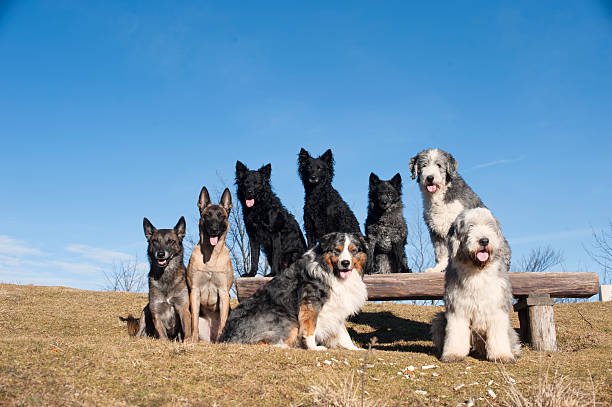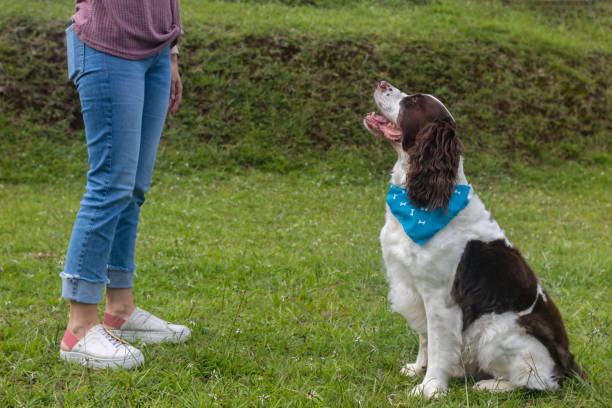Several strategies can be employed when using training collars to discipline your dog. One way involves placing the collar on your dog and keeping the leash short, which stops your dog from pulling on the leash. A different strategy may require attaching the collar to your dog and then securing it to the leash. By doing so, every time your dog tries to pull the leash, it will result in a reciprocal tug, thereby effectively restraining your dog.
Types of Dog Training Collars
Different training collars are available, so it cannot be easy to know which one is right for you and your dog. Some of these collars can cause harm and trauma to your dogs. It’s always best to use positive reinforcement as a training tool to keep your dogs healthy and happy.
Some collars are designed to only be worn when your dog is on a leash. There are two types of these, the head collar and the body harness.
The head collar fits around your dog’s neck like a scarf and can be adjusted in length. The body harness fits around your dog’s chest and back. The harness holds their “arms” in place so they can’t pull on the leash.
Dog training collars come in all shapes and sizes, but they all have the same purpose: to provide correction or guidance to your pet. There are four main collars: choke chains, pinch collars, electronic or shock collars, and head halters.
Choke Collars
A choke chain or prong collar is made of metal and is slipped over your dog’s head like a necklace. It tightens around your dog’s neck when you pull on the chain, correcting your dog’s direction. Choking the dogs can cause them pain even for a split second. The prong collar is still a harmful training tool.
Pinch Collar
Pinch collars are made of plastic and come in a variety of varieties. They attach to the dog’s neck with Velcro, which is applied by squeezing the collar. The amount of pressure depends on the size of your hand.


E-Collar
An electronic dog training collar is similar to a pinch collar but is plastic. A thin wire runs along the back of the dog’s neck, and if it is worn too tight, it will cause pain and discomfort for your dog.
Electric Dog Training Collars or Shock Collars
A few different types of training collars can be used with your dog. The most common type is the electric dog collar. This type of collar shocks the dog when it does something that is not allowed, like barking or jumping up on someone. The shock collar is controversial to use because of the way it disciplines your dog. Using this collar correctly and only use it as a last resort is important.


Remote Dog Training Collar
Remote training collars are a great way to train your dog. They offer a variety of ways to use them, which can be beneficial for both you and your pet. The most common use is as a remote collar. This means that you can activate the collar by pressing a button on the remote control. This is a great collar to use for your dog to learn obedience, as it allows you to give your dog commands from a distance.
Another use for Remote Training Collars is as a Bark Collar
Remote training collars can be used for so many different things. One of those things is as a bark collar. If you have a dog that barks excessively, a bark collar can help your dog learn to stop. The bark collar will activate when it detects barking and then corrects the dog. This will help to teach them that barking is not acceptable. Some people use remote training collars to keep their pets in the yard.
If you want your pet to stay inside, it is possible to teach them to sit or stay without using a collar. The remote training collar is a great alternative to the traditional pet collar. The pet collar can be used for many different things, but it is inappropriate for some situations. The pet collar will not work well if you want to teach your dog to walk on a leash.
How to Introduce the Dog Training Collars to your Pet
Introducing a collar for training your dog can be a daunting task. There are different ways to use a collar for training, and it is important to find the right way to introduce it to your dog. Some dogs respond well to a gentle introduction, while others need a more firm approach. The following are three tips for introducing the collar to your dog.
1. Introduce the collar to your dog gradually.


2. Introduce the collar at a time when your dog is calm and relaxed.
3. Do not increase the collar size until your dog responds well to it.
4. Keep the collar on your dog for a short period (5-10 minutes) before you start training with it.
5. For the easiest way to introduce your dog to a training collar, use the “Clicker training method.” A clicker is a tool that can be used to train your dog. Once you have the collar on your dog, the next step is to adjust the settings. For this, you will need to determine how many corrections your dog receives. A dog’s most common number of corrections is one correction that fails to respond correctly every two seconds.
6. When your dog responds correctly, give him a click and reward him with a treat or some playtime.
7. Do this for about 10-15 minutes each day for at least two weeks to teach your dog that it is good to respond correctly.
8. When your dog has been trained for about two weeks, start clicker training on a five-second schedule. Begin by clicking when your dog is lying down, then move to other activities like sitting or walking.
Using a training collar correctly can make all the difference in your dog’s behavior. Keep these tips in mind when using it:
1. Always supervise your dog when using the training collar.
2. Your dog should have a full field of view to see you and other people/dogs.
3. Be careful not to choke your dog with the collar.
4. Pay attention to your dog’s reaction and body language when wearing the collar.
5. If you feel your dog is not sitting calmly enough or that he is pulling on the leash, take it off immediately.
6. When using the collar, ensure your dog is not distracted by other dogs or people.
7. If your dog shows signs of aggression towards other dogs or people, you should use a head halter instead.
8. Don’t use the training collar as punishment; it can make your dog feel bad!
9. If your dog gets distracted and pulls on the leash, you must stop using the training collar immediately.
10. Always train your dog for the highest level you can achieve.
11. When training your dog, don’t use the training collar if he is in a situation that may cause him to become stressed or aggressive.
12. Once your dog has been trained, always keep it on him when you are not around.
How to Use Dog Training Collar Correctly
When it comes to using a training collar, there are a few different ways to do it correctly. First, make sure the collar is the right size for your dog. It should be snug but not tight. If it’s too tight, it could cause discomfort or injury. The next step is to fit the collar properly. The training collar should fit snugly around your dog’s neck, with enough room to fit two fingers between the collar and your dog’s neck.
Once you have the right collar size and it fits correctly, the next step is to ensure that your dog doesn’t react to the training collar. If he does, don’t use it. Next, make sure that you control your dog’s environment and keep him away from any objects he could choke on. If your dog reacts to the training collar, it won’t be easy to use it correctly.
Different Ways to Use a Dog Training Collar
A training collar is one of the most important equipment for a dog. There are many different ways to use a training collar, depending on your goal. Some of the most common uses are as follows:
1. To keep your dog from pulling on the leash
2. To keep your dog from jumping on people
3. To teach your dog to sit, down, or stay
4. To keep your dog from chewing things
5. To help train your dog to walk on a leash
6. To train your dog the heel command
7. To train your dog to come when called
8. To train your dog to walk with a loose leash
9. To prevent your dog from running off
10. For crate training your puppy (or any other type of training)
11. For home security training
12. To help your dog with obedience training
13. To get your dog to walk without pulling on his leash
14. To teach your dog to stay in the yard
15. To teach your dog to be a good companion dog
16. To help housetrain your puppy
17. To train your dog to be a good family pet
Final Thought
Training collars come in various shapes and sizes, each with a unique set of benefits and drawbacks. Before purchasing a training collar, it is important to consider your dog’s personality, behavior, and training goals. You can consult a professional trainer to guide you with your dog training.


